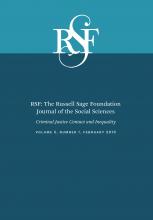Abstract
Police are responsible for producing about one-fifth of all reports of child abuse and neglect investigated by local child welfare agencies, and low-level interactions with police often result in the initiation of a child welfare investigation. Because police contact is not randomly or equitably distributed across populations, policing has likely spillover consequences on racial inequities in child welfare outcomes. This study shows that police file more reports of child abuse and neglect in counties with high arrest rates, and that policing helps explain high rates of maltreatment investigations of American Indian–Alaska Native children and families. The spatial and social distribution of policing affects which children and families experience unnecessary child protection interventions and which children who are victims of maltreatment go unnoticed.
- © 2019 Russell Sage Foundation. Edwards, Frank. 2019. “Family Surveillance: Police and the Reporting of Child Abuse and Neglect.” RSF: The Russell Sage Foundation Journal of the Social Sciences 5(1): 50–70. DOI: 10.7758/RSF.2019.5.1.03. Direct correspondence to: Frank Edwards at fedwards{at}cornell.edu, Martha Van Rensselaer Hall, Room 1302D, Cornell University, Ithaca, NY 14850.
Open Access Policy: RSF: The Russell Sage Foundation Journal of the Social Sciences is an open access journal. This article is published under a Creative Commons Attribution-NonCommercial-NoDerivs 3.0 Unported License.






